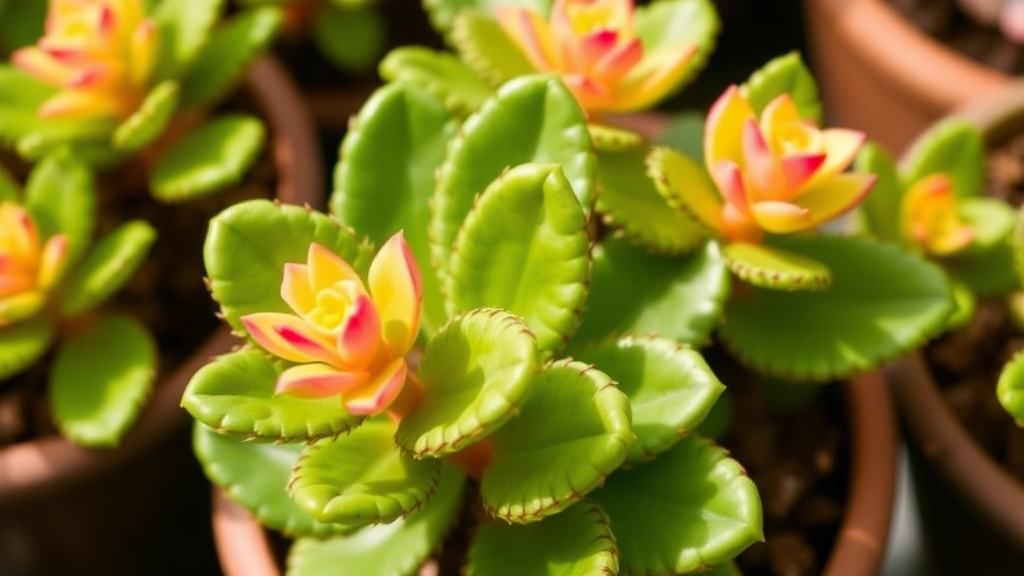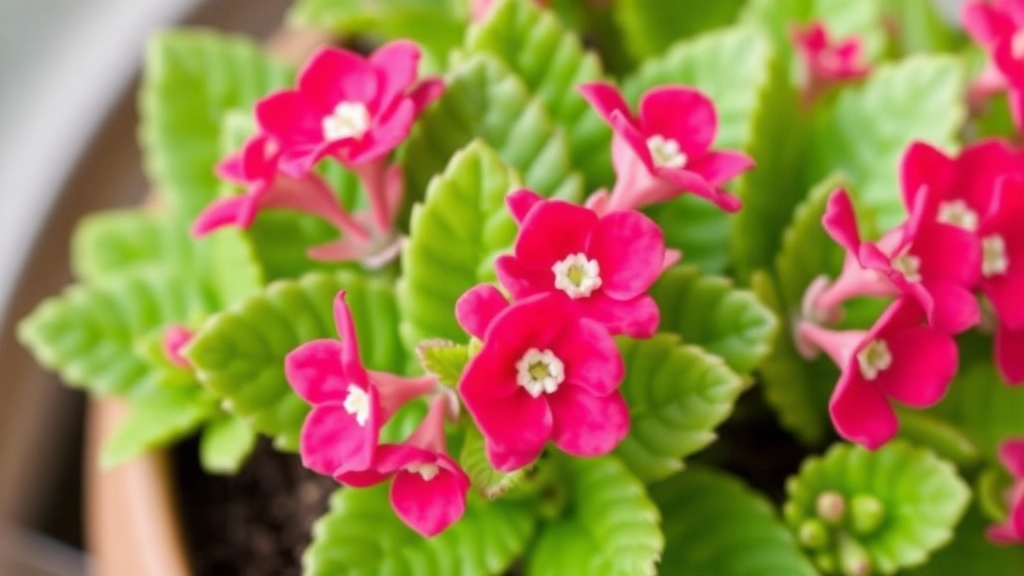Can Kalanchoe Grow from Leaves?
Ever wondered, “Can Kalanchoe grow from leaves?” You’re in the right place. As a plant enthusiast, I’ve explored various propagation methods, and leaf propagation for Kalanchoe is both fascinating and rewarding. It’s a straightforward process that even beginners can master. Let’s dive into the steps to grow your own Kalanchoe from leaves and enjoy the beauty of these resilient plants.
Steps to Propagate Kalanchoe from Leaves
First, select a healthy leaf from your Kalanchoe plant. Gently twist and pull it off, ensuring you get a clean break. Place the leaf on a dry surface for a few days to let the cut end callous over. This step is crucial to prevent rot. Once the end is calloused, lay the leaf on top of well-draining soil. Mist lightly and keep it in a bright, indirect light. In a few weeks, you’ll notice tiny roots and new growth emerging, signaling the start of a new Kalanchoe plant.
Propagation Methods for Kalanchoe
When it comes to propagating Kalanchoe, many enthusiasts often wonder about the best methods to achieve successful growth.
Kalanchoe, a resilient succulent, can be propagated through various methods, each with its own unique benefits.
Here are the most common propagation techniques:
- Leaf Cuttings: This is one of the simplest and most effective methods. By taking a healthy leaf and allowing it to callous before planting, you can encourage new growth. For a detailed guide, you can refer to the step-by-step guide to grow Kalanchoe from leaf cuttings.
- Stem Cuttings: Similar to leaf cuttings, stem cuttings involve taking a section of the stem, allowing it to dry, and then planting it in soil.
- Offsets: Kalanchoe often produces offsets or âpupsâ that can be separated from the parent plant and replanted.
- Seeds: Although less common, Kalanchoe can also be grown from seeds. This method requires more patience and specific conditions.
Each of these methods presents its own challenges and rewards, making it essential to choose the one that aligns best with your gardening style. For more comprehensive information, check out the comprehensive Kalanchoe plant care guide.
Step-by-Step Guide to Growing Kalanchoe from Leaves

So, you’re eager to propagate Kalanchoe from leaves, huh? I totally get it! It’s a simple and rewarding way to expand your plant family. Let’s dive into the nitty-gritty of how to do it right.
Step 1: Gather Your Materials
First things first, you’ll need a few essentials:
- Healthy Kalanchoe plant: Pick a vibrant one with no signs of disease.
- Sharp scissors or a knife: Clean cuts are key.
- Potting soil: A well-draining mix is ideal.
- Small pots or trays: For your new leaf cuttings.
- Water: Just enough to moisten the soil.
Step 2: Take Leaf Cuttings
Now, let’s get to the fun part—taking those leaf cuttings!
- Choose a few healthy leaves from the plant.
- With your sharp scissors or knife, cut the leaf at the base, ensuring you don’t damage the mother plant.
- Aim for leaves that are plump and firm; these will have the best chance of rooting.
Step 3: Let Them Callous
After cutting, it’s time for a little patience. Place the leaves in a dry, warm spot for about 1-3 days. This allows the cut edges to callous over, which helps prevent rot when you plant them.
Step 4: Prepare the Soil
While the leaves are drying, get your pots ready!
- Fill your pots or trays with the well-draining potting soil.
- Lightly moisten the soil, but don’t soak it. Too much water can lead to problems down the line.
Step 5: Plant the Cuttings
Now, let’s get those leaves in the soil.
- Lay each leaf flat on the soil surface.
- Gently press down the base of the leaf into the soil, ensuring it’s secure but not buried too deep.
- Leave some space between each leaf to give them room to grow.
Step 6: Water and Wait
Once everything’s planted, it’s time to water them lightly again.
- Keep the soil slightly moist but not soggy.
- Place the pots in a warm area with bright, indirect sunlight.
Step 7: Watch Them Grow
Now comes the exciting part!
- In a few weeks, you should start to see little roots developing.
- Once you notice new growth, you can gradually increase the water and sunlight.
Ideal Conditions for Leaf Propagation
When embarking on the journey of Kalanchoe leaf propagation, understanding the ideal conditions is crucial for success.
Many beginners often wonder: What environment do Kalanchoe leaves thrive in during propagation?
To ensure your Kalanchoe leaves take root and flourish, consider the following conditions:
- Light: Kalanchoe prefers bright, indirect sunlight. Too much direct sun can scorch the leaves, while too little light can hinder growth. A south or west-facing window is often ideal.
- Temperature: These plants thrive in warm conditions, ideally between 20°C and 25°C (68°F to 77°F). Avoid exposing them to temperatures below 10°C (50°F), as this can stunt their growth.
- Humidity: Kalanchoe is a succulent, meaning it prefers lower humidity levels. Aim for a humidity range of 40% to 60%. Too much moisture can lead to rot.
- Soil: Use a well-draining potting mix, specifically designed for succulents. A mix containing perlite or sand helps prevent water retention.
- Watering: Allow the soil to dry out completely between waterings. Overwatering is a common mistake that can lead to leaf rot.
By creating these optimal conditions, your Kalanchoe leaves will have the best chance of rooting successfully. For more detailed information on caring for Kalanchoe succulents, check out our ultimate care guide. Additionally, if you’re interested in specific varieties, our guide to Kalanchoe varieties offers valuable insights.
Common Challenges and Solutions

When propagating Kalanchoe from leaves, various challenges may arise that can hinder your success.
1. Leaf Rot
One of the most common issues is leaf rot, which occurs when leaves sit in water for too long.
- Solution:
- Ensure well-draining soil.
- Water only when the soil is dry to the touch.
- Use a clean, sharp knife to cut leaves to prevent infection.
2. Insufficient Rooting
Sometimes, leaves may take longer to root than expected, leading to frustration.
- Solution:
- Place the leaves in a warm, bright location but avoid direct sunlight.
- Be patient; roots can take several weeks to develop.
3. Pests
Pests like mealybugs or aphids can attack your Kalanchoe leaves, affecting their health.
- Solution:
- Regularly inspect your plants.
- Use neem oil or insecticidal soap to treat infestations.
4. Overexposure to Sunlight
While Kalanchoe loves light, too much direct sunlight can scorch the leaves.
- Solution:
- Provide bright, indirect light.
- If you notice leaves turning brown, move the plant to a shadier spot.
5. Poor Soil Quality
Using the wrong soil mix can lead to poor growth and health issues.
- Solution:
- Opt for a cactus or succulent mix that promotes drainage.
- Consider adding perlite for extra aeration.
Tips for Healthy Kalanchoe Growth
When it comes to nurturing your Kalanchoe, you might be wondering how to ensure it thrives.
Here are some straightforward tips to help you cultivate a healthy plant:
- Light Requirements: Kalanchoe loves bright, indirect sunlight. Place it near a window where it can soak up the rays without getting scorched.
- Watering Wisely: Overwatering is a common mistake. Allow the soil to dry out completely between watering sessions. A good rule of thumb is to water every two to three weeks, depending on your environment.
- Soil Selection: Use a well-draining potting mix. A cactus or succulent blend works wonders, preventing root rot.
- Temperature and Humidity: Kalanchoe prefers warm temperatures between 20°C to 25°C. It’s not a fan of cold drafts, so keep it away from chilly areas.
- Fertilising: During the growing season (spring and summer), apply a diluted, balanced fertiliser every month to provide essential nutrients.
- Pruning: Regularly remove dead or yellowing leaves to promote new growth and maintain the plant’s appearance. For more detailed steps, check out our pruning guide for leggy Kalanchoe.
- Pest Control: Keep an eye out for pests like mealybugs and aphids. A gentle spray of water or a mild insecticidal soap can help manage these nuisances. For additional care tips, visit our Flaming Katy care guide.
Frequently Asked Questions About Kalanchoe Propagation
So, you’ve got questions about Kalanchoe propagation? You’re not alone! Many plant lovers are keen to dive into this rewarding journey. Let’s tackle some of the most common queries I hear.
How long does it take for Kalanchoe leaves to root?
Typically, you can expect to see roots forming in about 2 to 4 weeks.
- Patience is key!
- Keep your leaves in a warm, bright spot but out of direct sunlight to encourage growth.
Can I propagate Kalanchoe in water?
While it’s possible, I’ve found that soil propagation tends to yield better results.
- Soil offers nutrients that water alone can’t provide.
- If you choose water, ensure the leaf is submerged just enough to cover the base.
What’s the best time of year to propagate Kalanchoe?
Spring is your best bet!
- Plants are waking up from dormancy, making them more receptive to propagation.
- You can try in other seasons, but spring gives you the best chance for success.
How do I know if my leaf is healthy enough for propagation?
Look for leaves that are:
- Firm and plump
- Free from spots or damage
- Generally healthy-looking
What if my Kalanchoe leaves are wilting?
Wilting can happen for a few reasons:
- Too much or too little water can cause stress.
- Ensure your leaves are in well-draining soil and check your watering routine.
Can I propagate Kalanchoe from cuttings instead of leaves?
Absolutely! Check out this guide on propagating Kalanchoe from leaves for more details.
- Cuttings can be a great way to propagate, just make sure to let them dry out for a day or two before planting.
- That helps prevent rot.
How do I care for my new Kalanchoe plants?
Once your new plants are established, keep these tips in mind:
- Bright, indirect light is crucial.
- Water only when the top inch of soil is dry.
- Fertilize every few months during the growing season for optimal growth.
For more detailed care tips, you might find this complete guide to Kalanchoe plant care useful.
FAQs on Growing Kalanchoe from Leaves
Can Kalanchoe grow from leaves?
Yes, Kalanchoe can be propagated from leaves. It is a simple and rewarding method to expand your plant collection.
What materials do I need to propagate Kalanchoe from leaves?
You will need a healthy Kalanchoe plant, sharp scissors or a knife, well-draining potting soil, small pots or trays, and water.
How do I take leaf cuttings from a Kalanchoe plant?
Choose healthy leaves, cut them at the base with sharp scissors or a knife, and ensure the leaves are plump and firm for the best chances of rooting.
Why do I need to let the leaf cuttings callous?
Allowing the cut edges to callous over for 1-3 days helps prevent rot when you plant them in soil.
What type of soil is best for Kalanchoe leaf cuttings?
A well-draining potting mix, ideally a cactus or succulent mix, is best for Kalanchoe leaf cuttings. You can also add perlite for extra aeration.
How should I plant the Kalanchoe leaf cuttings?
Lay each leaf flat on the soil surface, gently pressing down the base into the soil without burying it too deep. Leave space between each leaf for growth.
How often should I water the Kalanchoe leaf cuttings?
Keep the soil slightly moist but not soggy. Water lightly and only when the soil is dry to the touch.
Where should I place the pots with Kalanchoe leaf cuttings?
Place the pots in a warm area with bright, indirect sunlight. Avoid direct sunlight to prevent scorching the leaves.
How long does it take for Kalanchoe leaf cuttings to root?
It can take several weeks for roots to develop. Be patient and monitor the cuttings for new growth before increasing water and sunlight.
What should I do if my Kalanchoe leaves start to rot?
Ensure well-draining soil, water only when the soil is dry, and use a clean, sharp knife for cutting leaves to prevent infection.
How can I prevent pests from affecting my Kalanchoe leaf cuttings?
Regularly inspect your plants and use neem oil or insecticidal soap to treat any infestations of pests like mealybugs or aphids.
What should I do if my Kalanchoe leaves are overexposed to sunlight?
Provide bright, indirect light and move the plant to a shadier spot if you notice leaves turning brown due to excessive sun exposure.
References
-
How To Propagate Kalanchoe Plants – Gardening Know How
-
How to Grow Kalanchoe Indoors – The Spruce
-
Kalanchoe: How to Grow and Care for Kalanchoe Plants – The Old Farmer’s Almanac
